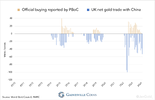DrBourse
If you don't Ask, you don't Get.
- Joined
- 14 January 2010
- Posts
- 891
- Reactions
- 2,112
There ya go eskys, as I suggested after your first 2502 post, and as gg shows, "That is the Dec 24 Gold Futures price, not the Spot Gold price....GG, You've added to my confusion....thought I found it, now I'm lost again














